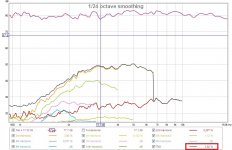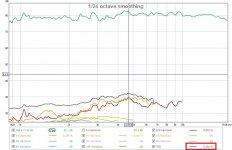Who cares? Single digit (collapsed) distortion measures as typically done are next to meaningless.
dave
dave
well, i do care!Who cares? Single digit (collapsed) distortion measures as typically done are next to meaningless.
dave
Cause i certainly don't like the sound of 4% (four) distortion in the high end.
i made some measurements myself and the results are puzzling me: same room, same speakers, same position, same levels, same microphone - only the amps change. Some amps show low distortion values (0.2-0.4%) over the whole mid+high range, others show high values (2.0-3.8%). Of course the amps measured by them selfs show all values under 0.01%.
What could be the cause for this behaviour?
That is very interesting. Any link to the results? What speakers where those or at least their specs? And just to confirm, also same wires and source were used?
the speakers used were Tyler Acoustics - D3M.
As a source i used a D/A converter from TC-Electronics BMC-2.
Everything else except the amps stayed the same.
The amp that measure high distortion values were Abacus 60-120C Power Edition and ATOLL AM 200 = see left measurement labeled 'dist_high'.
The other amps that measure low distortion values were Block Audio - A-100, an elder Onkyo A-8015 and my current NC400 = see right measurement labeld 'dist_low'.
As a source i used a D/A converter from TC-Electronics BMC-2.
Everything else except the amps stayed the same.
The amp that measure high distortion values were Abacus 60-120C Power Edition and ATOLL AM 200 = see left measurement labeled 'dist_high'.
The other amps that measure low distortion values were Block Audio - A-100, an elder Onkyo A-8015 and my current NC400 = see right measurement labeld 'dist_low'.
Attachments
not really.
One more thing: i changed the original tweeter with a Morel CAT-328 and also the xover, that is rather simple. So over 2-3kHz it's mostly the plain impedance of the tweeter.
One more thing: i changed the original tweeter with a Morel CAT-328 and also the xover, that is rather simple. So over 2-3kHz it's mostly the plain impedance of the tweeter.
And of course each amp was measured several times? And the variation of the measurements were statistically significant if the error between the measurements was also taken into account?
yes, the high dist amps have been measured more than 20 times, on different days, as i had them for several weeks for testing.
Result have been consistent.
Result have been consistent.
what i ment was that the 'more than 20' measurements were not done one after the other, on the same day, but over a span of 3 weeks.
With a ratio of more than 10:1 in distortion figures, it's hard to write it all off as experimental error.
what i ment was that the 'more than 20' measurements were not done one after the other, on the same day, but over a span of 3 weeks.
Were the results expected to change? I would expect any device that has "burned in" to remain constant.
yes, the high dist amps have been measured more than 20 times, on different days, as i had them for several weeks for testing.
Result have been consistent.
Sweet! Any chance we can see more than just the db curves?
@troystg: i was puzzled by the results and had hoped that it would change after burn in - it was not the case, so i returned both amps.
@3lviz: if you have REW i can send you the measurement file. PM me your email address.
@3lviz: if you have REW i can send you the measurement file. PM me your email address.
well, i do care!
Cause i certainly don't like the sound of 4% (four) distortion in the high end.
But the single number is meanigless. If it is all 2nd orderit might not be too bad, if it is all high order it is terrible... thettal percent is meaningless.You need to know the distribution of the harmonics.
dave
well, you can look for yourself in the pictures i posted in #7304 - the high THD it's mostly formed by third and fifth ...But the single number is meanigless. If it is all 2nd orderit might not be too bad, if it is all high order it is terrible... thettal percent is meaningless.You need to know the distribution of the harmonics.
dave
Ideally, the distortion should be monotonically decreasing with order. Anything high order over the 3rd you want to worry about.
dave
dave
what i ment was that the 'more than 20' measurements were not done one after the other, on the same day, but over a span of 3 weeks.
Were they all measured at the same level? It would be interesting to see the results at a lower or higher level (maybe 10 dB up/down).
i made some measurements myself and the results are puzzling me:
Could you detail your test setup please?
- Status
- Not open for further replies.
- Home
- Amplifiers
- Class D
- Hypex Ncore

